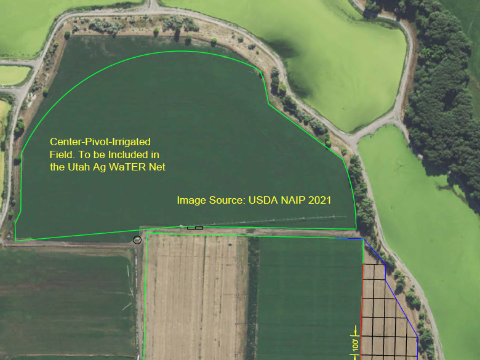A network of agricultural observation sites providing a live-feed of irrigation water balance and crop production data to facilitate education, Extension outreach, and research on agricultural water optimization in Utah.
Network Description
The aim of the Utah Ag Water Network is to address and support many long-term needs of agricultural irrigation science, education, decision-making, and Extension activities across Utah. The network will support USU’s land-grant mission by providing resources for: teaching agriculture and irrigation science, USU Extension activities, and promoting research in irrigation water use and associated driving factors throughout Utah.
The network is intended to address agricultural water optimization information needs by focusing on four major areas:
- Irrigation water monitoring standards and protocols,
- Technology impacts on irrigated agriculture,
- Data availability, and
- Economic impact.
These four components will be integrated within agricultural observation sites (AOS). These AOSs will be selected farm sites in major crop production regions of Utah. The AOSs will be used to collect continuous water balance, cultural activity, and yield data.
Questions the Utah Ag WaTER Net is Helping to Solve
- Given the varying climate and water availability in Utah, what are the water optimization opportunities that can be promoted in Utah while supporting thriving agriculture and rural communities in the state? How do these opportunities vary over time and climate conditions (wet vs. dry years) now and into the future (the next 5, 10, 25 years)?
- What are the recommended technology packages that Utah producers can adopt, allowing them to be profitable and have effective control over irrigation water with positive economic and water management impacts? Do these packages vary across Utah?
- Can these technology packages support optimal use of available water for drought-driven practices like partial fallowing, deficit irrigation, or water markets/banking?
Utah Ag WaTER Net Components and Purposes
|
Component |
Activity |
Purpose |
|
Water monitoring standards and protocols |
Assessment and ranking (accuracy, precision) of sensors and technologies for farm water balance component monitoring |
Implementation of a USU water instrument validation bank |
|
Protocols for installation, maintenance, and validation of sensor/instrument information |
Development of best practice documentation for water balance component sensors |
|
|
Technologies / tools impact on water balance and optimization |
AOS site selection and access |
Explore synergistic opportunities with Utah producers, existing agricultural water optimization efforts, and USU for land access (or purchase) |
|
Site design, instrumentation, and maintenance |
Monitor water balance components for traditional knowledge, ground sensors, emerging technologies and permanent fallowing or dryland conditions |
|
|
Water optimization metrics |
Evaluate existing or develop new metrics to assess water optimization and water application within the season |
|
|
Site operation and yield data collection campaigns |
Field visits for yield data collection and non-continuous data (e.g., drones, irrigation system evaluations) |
|
|
Documentation of decision-making processes on irrigation, cultural activities, and yield |
Farm operations journal (date entries on farm activities and information sources used for water management, harvest, others) |
|
|
Repository and data access solutions identification/ collaboration |
Online platform for easy, direct data visualization at different time scales (e.g., hourly, daily, monthly, seasonal) per site and across the project |
Identify and develop solutions like the Utah Climate Center for data visualization and access |
|
Data repository (time series, spatial features, raster, journal entry) |
Identify and enhance solutions for long-term data ingestion and machine readability |
|
|
Economic Impact |
Economic impact of the different technology packages and solutions. |
Tracking of irrigation times, electricity costs, labor, and management needed to operate the system and decision-making activities, and tracking of crop prices |
|
Water management impact by different technology packages and solutions |
Tracking of ease of use, learning effort, and time invested using the different technology packages |
Utah Ag WaTER Net's Connection to USU's Land-Grant Mission
Teaching
- Providing local, curated, information for USU and other Utah students to receive hands-on experience with irrigation management, technologies, and tools.
Extension
- Providing a live feed of irrigation management for the AOS farms including water balance, crop inputs, and yield. The live feed website can be incorporated into Extension outreach materials.
- Providing locations for field days and workshops.
Research
- Assessment and development of solutions for irrigation water management (e.g., traditional practices vs. existing and incoming instrumentation and technologies).
- Development and assessment of precision agriculture solutions based on available farm technology (conventional or variable rate irrigation).
- Yield and input monitoring to quantify economic costs/benefits of tested solutions.
- Supporting indirect research
- Precision agriculture research (e.g., drones, remote sensing, smart farming, variable rate technology).
- A network of USU test sites to support proposal development (e.g., new sensors, protocols, approaches) connected to irrigation water management.
- Use of water management strategies (full vs. partial fallowing).
- Alternative water sources as primary or supplementary supplies (e.g., greywater).
- Soil health and carbon sequestration.
Additional Opportunities for USU and Industry
- Collaboration with industry (local and U.S.) and
- Assessment of emerging commercial products to address water management or crop monitoring (e.g., ground instrumentation, stress, monitoring equipment, and data).
Utah Ag WaTER Net's Pilot AOS
A pilot observation site is being designed for the USU Wellsville farm. This site will be used to kickstart the development of protocols for site selection and instrumentation. The site (a half center pivot) has an irrigated area of 32 acres. The site is in Wellsville, UT, next to existing research plots and a proposed subsurface drip irrigation research field.
Lead Team Members
Alfonso Torres-Rua
Burdette Barker
Other USU Partners
USU Extension
The Utah Agricultural Experiment Station
The Utah Water Research Laboratory
External Parnters
...

